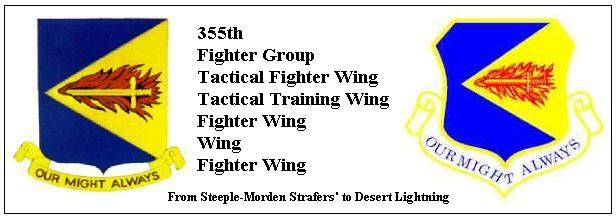

During its existence, the 355th has flown many different aircraft in the performance of its missions. The P-51 Mustang, the F-105 Thunderchief and the A-10 Thunderbolt II to name a few. Below is a brief rundown on them.
This page is still under construction...
On November 12, 1942, the 355th Fighter Group was activated at Orlando Army Base Florida. The Group consisted of the 354th, 357th and 358th Fighter Squadrons. In July of 1943 the Group deployed to Steeple Morden England, beginning combat operations September 1st with its last mission on April 5, 1945 against the rail yards at Hallein Germany.
The 355th flew the F-86 "L" model during the 1955 to 1958 time frame. The "L" model was an upgraded "D" model. Included in the upgrade was AN/ARR-39 Datalink receiver and the AN/ARC-34 radio replaced the AN/ARC-27 unit. AN/APX-25 identification radar and the AN/ARN-31 glide slope receiver were also added.
F-86F-40 wings were added. This wing modification added 12 inch wing extensions and new leading edge slats which improved handling at altitude.
Crew: one (1)
Engine: one (1) General Electric J47-GE-33 Turbojet 5,550 Lbs of thrust
Wingspan: 39 feet 1 inch
Length: 40 feet 4 inches
Height: 15 feet 0 inches
Weight: 13,882 Lbs empty; 18,484 loaded
Speed: Max 693 MPH; Cruise 540 MPH
Range: 1200 miles
Service Cieling: 49,600 feet
Armament: 24 2.75 inch unguided folding fin rockets
Cost: $343,839
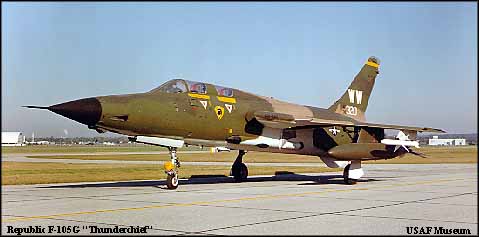
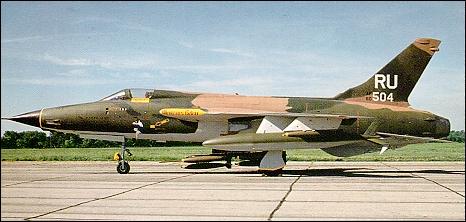
The wing earned its first of three Presidential Unit Citations for action from January 1, 1966 to October 10, 1966. During this time period the wing flew 11,892 sorties, downed 2 MiG's and damaged 8 more.
On March 10, 1967 Captain Max Brestel shot down 2 MiG-17's for the first double kill. October 8, 1967 was also a good day for the wing. Pilots from the wing shot down 2 Mi-6 and 4-Mi-4 helicopters. October 24, 1967 the wing attacked and left unserviceable the air field at Phuc Yen 18 miles north of Hanoi and the largest in North Vietnam. Prior to the raid, the air field had been untouched. December 14, 1967 the wing attacked and downed the Paul Doumer bridge.
By April 1968 the wing had accumalated 100,000 combat hours. In May 1968, the F-105 known as "Baby Doll" had reached 3,500 hours
In January 1970, the wing receievd its second Presidential Unit Citation for action from August 11-12, 1967 and October 24-28, 1967. The third Presidential Unit Citation was awarded in July 1970 for action from April 12, 1968 to April 30, 1969. During this time frame, the wing dropped 32,000 tons of ordinance on 2,100 targets while flying 17,000 combat sorties.
The wing's last F-105 combat mission of the war was "DINO" flight led by Col. Waymond C. Nutt. The mission was an airstrike in Laos. The wing was deactivated on December 10, 1970. Since arriving in November 1965, the 355th flew 101,304 sorties logging 263,650 hours, dropped 202,596 tons of ordinance on 12,675 targets, and shot down 19 MiG's.
The F-105 program was a private venture by Republic as a continuation of its F-84F Thunderstreak series of aircraft. Conceived as a supersonic nuclear tactical strike fighter under the project name AP-63, the F-105 was to be powered by an Allison J71 engine, which was later updated to the Pratt & Whitney J57. In March 1952, Republic submitted its design to the Department of Defense and was awarded a contract followed in March 1953 with an order for 37 aircraft to be designated the XF-105A0. This order was later reduced to 15 with delivery to be in November 1955. With changing requirements, the Pratt & Whitney J57 engine was replaced with the Pratt & Whitney J75 and redesignated the YF-105B in August 1954. Of the original 15 aircraft, 3 were to be the RB-105B reconnaissance version. Due to further DoD changes, these 3 were completed as JF-105's to be used as instructional aircraft.
The first test flight of YF-105A (54-0098) was on October 22, 1955 and the pilot was Russell M. "Rusty" Roth. May 26, 1956 saw the first test flight of the F-105B-1RE (54-0100) production version with the delivery of the first F-105B-6RE (54-0111) to the 335TFS/4TFW on May 26, 1958. The 334TFS and the 336TFS also received the F-105B's while the 333TFS was the first to be equipped with the new "D" model. A total of 75 "B" models were built.
The "D" model variant saw the addition of the APN-131 Doppler airborne navigation system, the ASG-19 fire control system, and a Bendix toss bomb computer. The main visible change was the 15-inch nose extension on which the pitot tube was mounted. The J75-P-19W water-injected engine was also added.
A two seat trainer variant F-105C was started using the airframe of JF-105 (54-0105) but was halted due to high costs and the two seat all weather fighter-bomber variant F-105E was initiated but quickly stopped with those under construction being completed as "D" models.
The USAF accepted the F-105F two-seat trainer/tactical fighter version and 143 were ordered. The F-105F was lengthened by 2 feet to accommodate the second cockpit. The first F-105F (62-4412) flew on July 11, 1963. With poor visibility from the rear cockpit, the "F" model was not practical for conventional training purposes. However the value of the "F" model became apparent in SEA as a "Wild Weasel" in its SAM suppression role.
In all, 833 F-105's were built. Broken down by model: 2 YF-105's, 3 JF-105's, 75 "B", 610 "D" and 143 "F" models.
No other aircraft, USAF or Navy, carried more ordinance or flew more strike missions into North Vietnam than the F-105.
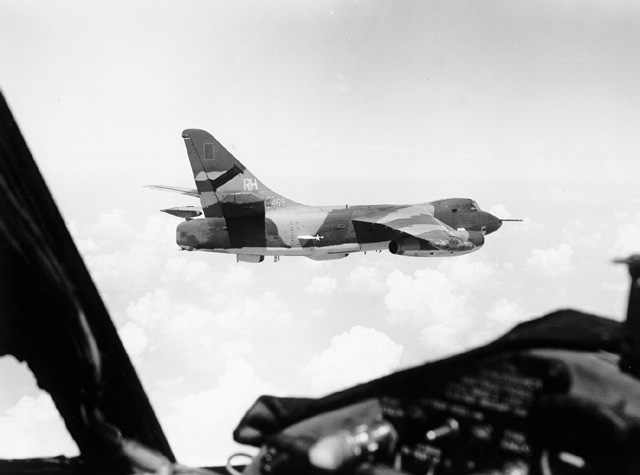
Prior to being converted to the "EB" electronic warfare configuration, the B-66's carried defensive guns in the tail. The gunner sat in the left rear seat. As part of the conversion, the tail guns were removed and replaced with chaff dispencers. The capacity was 300 pounds in both the right and left bays for a total of 600 pounds. The ECM gear was installed in the bomb bay via a pallet. For the seating arrangement, see the chart below.
| Position | EB-66B | EB-66C | EB-66E |
| Left Front | Pilot | Pilot | Pilot |
| Left Rear | EWO | IN's & IP's | Navigator |
| Right Rear | Navigator | Navigator | EWO |
| Mid Section | None | 4 - EWO's | None |
EWO = Electronic Warfare Officer
IP = Instructor Pilot
IN = Instructor Navigator
One of the hardest things to do on the EB-66 was the operational check of the emergency landing gear system. This operation required the aircraft be jacked up off the ground. It then took 300 pumps on the hand pump to lower the gears and, as you can imagine, it got harder to pump with each stroke.
In early 1967 a pilot, who had completed his required number of missions, buzzed the town, pulled straight up, put the aircraft over on its back and then landed. The aircraft suffered major structural damage to the wings. This aircraft was #53-0498 and on April 7, 1969 it was lost due to engine failure.

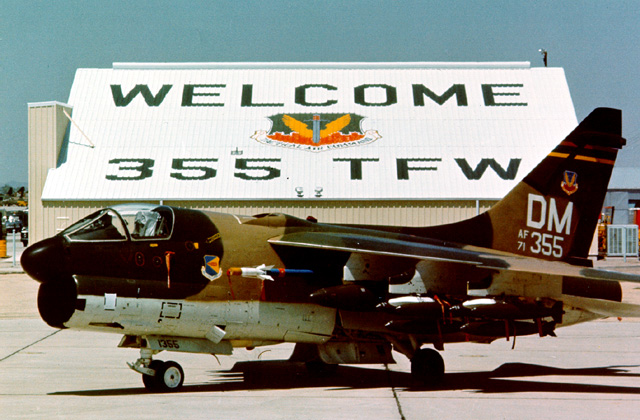
On July 1, 1971 the 355th Tactical Fighter Wing was reactivated at Davis-Monthan AFB, AZ. On July 16th, Col. John F. Barnes (Commander) and Col. Waymond C. Nutt (Deputy Commander of Operations) flew the wings' first A-7D's to Davis-Monthan AFB.
On November 15, 1972 the wing deployed 4 A-7D aircraft and 41 personnel to Howard AFB in the Panama Canal Zone to provide close air support for US Army training execises. The deployment was called Coronet Cove. These aircraft returned to Davis-Monthan AFB on February 1, 1974.
That deployment was followed by a six month TDY to Korat RTAFB in Thailand. A contingent of aircrews, mostly from the 354th TFS, flew air strikes into Cambodia. Known as Constant Guard VI, all personnel returned to Davis-Monthan AFB on July 12, 1973. A similiar deployment was made on December 21, 1973. The 355th deployed 23 pilots from the 358th TFS and 342 enlisted personnel to Korat RTAFB in Thailand to support the 354th Tactical Fighter Wing. All personnel supporting this deployment returned to Davis-Monthan AFB between May 16th-20th 1974.
On September 1, 1979 the 355th Tactical Fighter Wing was redesignated the 355th Tactical Training Wing. Just one month later on October 2, 1979 the 357th TFTS flew the last A-7D flight at Davis-Monthan AFB thus ending the 8 years of A-7D operations.
If you have any historical information, photo's, or personal stories that are related to the A-7's of the 355th TFW that you would like to share with me, please e-mail me at [email protected] Please remove the word "NOSPAM" from the e-mail address before sending e-mail.
The A-7 Corsair II was the result of the VAL (V=heavier than air, A=attack, L=light) study. Four designs were considered; one from Douglas Aircraft based on the A-4 Skyhawk, one from North American based on the FJ-1 Fury, one from Grumman based on the A-6 Intruder, and one from Vought based on the F-8U Crusader. In a time when everyone proclaimed the "Need for Speed", the Navy insisted that subsonic was actually the desired direction to go in order to achieve bombing accuracy. The Navy argued that even the faster fighter-bombers had to slow to subsonic speeds to deliver their ordinance and that most air to ground oridnance could not be delivered at supersonic speed anyway.
On February 11, 1964 Vought was declared the winner of the VAL competition. On September 27, 1965 the first A-7A made its first flight with the first operational A-7A delivered to VA-147 on October 14, 1966. By September 1967, the VA-147 had transitioned to the A-7A and within 3 months was flying the Corsair into combat. The A-7A's of the VA-147 squadron flew 1400 sorties with the lost of only one aircraft.
The Air Force was quick to notice the A-7 and started developing its own version, the A-7D. One of the main improvements made by the Air Force was the replacement of the Pratt & Whitney TF30-P-6 engine with the Allison (Spey) TF41-A-1 engine. The TF41-A-1 engine produced 14,500 LBS of thrust. Other changes included the removal of the Navy style refueling boom and catapult launch bar. The first 16 A-7D's retained the refuelinf boom. I believe most, if not all 16, of these aircraft were assigned to the 355th TFW since we had quite a few of them. These aircraft were refered to as "Block 1" aircraft. All remaining A-7D's, with the high speed receptacle, were refered to as "Block 2" aircraft.
Another improvement made by the Air Force, was the avonics package, which included the Heads Up Display or HUD. The first in ANY American combat aircraft. The Navigation and Weapons Delivery System included a Doppler radar system, inertia measurement set, air data computer, tactical computer, projected moving map display, armament control unit, and a forward looking radar that provided air to gound ranging, terrain following and terrain avoidance. These improvements made the A-7D Corsair II the best attack aircraft in the Air Force. Better than the A-10 that replaced it! The TISM "Pave Penny" pod was added later.
A-7D Variants built: 459
Engine:--------Allison TF41-A-1
Wing span:-----38.73 feet
Length:--------46.13 feet
Height:--------16.06 feet
Gross weight:--42,000 LBS
Empty weight:--19,780 LBS
Armament:------M61A1 20mm Cannon (1,008 rounds)
Speed:---------698 MPH (at sea level)
Range:---------2,280 miles (internal fuel only)2,871 miles (with 4-300 Gal external tanks)
Fuel:----------1,425 Gal (internal only)
Some of the information provided here was obtained from the "Detail & Scale" Volume 22 by Bert Kinzey.
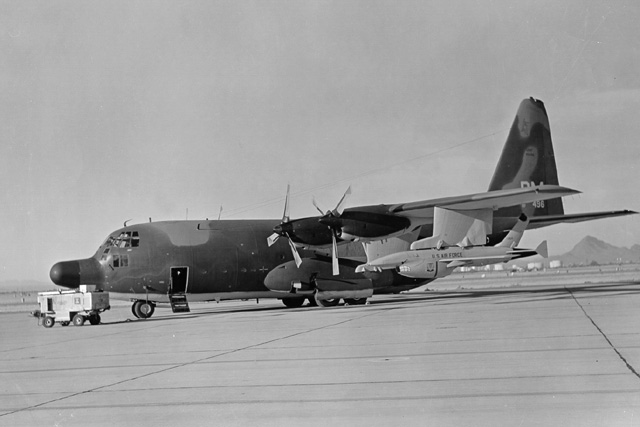

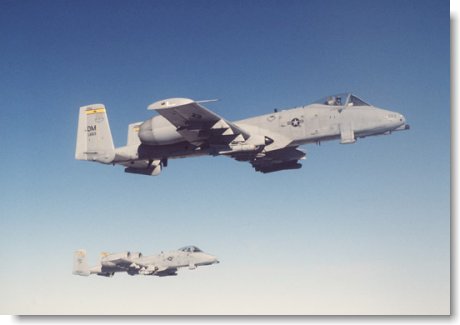
As a result of a 1966 tour of the war zone in Southeast Asia, Air Force Chief of Staff General John P. McConnell stated the need for an aircraft that would fill the true close air support role. STOL capability from rough airfields as well as the best characteristics of both the venerable A-1 Skyraider and the A-7 Corsair II. Although Requests For Proposals were sent out in March 1967, it wasn' until May 1970 that RFP's were sent out to 12 companies for competitive prototype development. Six companies submitted designs with Northrop (A-9) and Fairchild (A-10) being selected to build aircraft for evaluation. In January 1973, the Air Force announced that the A-10 was the winner.
A comparative fly-off with the A-7D was conducted at Fort Riley, Kansas. The 2 A-7D's involved with the fly-off were 73-993 and 73-994 from the 355th TFW. These aircraft were painted gunship grey.
The 333rd TFTS was selected to receive the first A-10A's. The 354th TFW was selected to become the first operational Air Combat Wing equipped with the A-10.
In March of 1976 the first A-10's arrived at Davis-Monthan AFB. The first few aircraft were 75-258, 75-259, 75-260, 75-261, and 75-262. Aircraft 75-261 is now in AMARC being used as a battle damage training aircraft. On March 15, 1985 the A-10 Demonstration Team was ready for 12th Air Force approval.
On December 5, 1986, Headquaters TAC annouced approval for using the A-10 in the forward air control mission. The 355th TTW and the 602nd Tactical Air Control Wing were ordered to jointly develop a concept of operations for the "OA-10".
The 355th TTW won the TAC Commander's Award for Top Aircraft Maintenance in the A-10 Category on May 31, 1989. On June 30th, the 355th TTW's entries were named "Best A-10 Team" during the Long Rifle V gunnery competition held at Seymour Johnson AFB, North Carolina.
In May of 1990, the 355th TTW once again won the TAC Commander's Award for Top Aircraft Maintenance in the A-10 Category. The 333rd TFTS was named "Best A-10 Team" during the Long Rifle VI competition held at Davis-Monthan AFB, Arizona in June of 1990. The 333rd TFTS placed third overall.
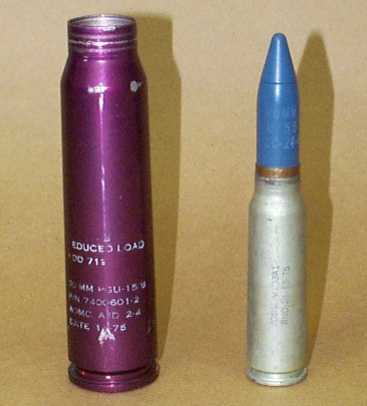
The above photograph shows a 30mm casing (left) out of the GAU-8 30mm cannon internally mounted on the A-10 Warthog and a 20mm casing and projectile (right) out of the M61 20mm cannon internally mounted on the A-7D Corsair II. Please note that both casings are made out of aluminum. The change from brass to aluminum for the 20mm rounds was made sometime in 1975 and I believe the 30mm rounds were made of aluminum from the beginning of its development for weight savings. Just for your information, the 20mm round on the right is NOT a "live" round. It is a spent casing with a projectile placed on it.
I worked out of the Gun Shop. I was there from March 1973 to May 1976. During the time that I was there, the wing flew the A-7D Corsair II aircraft. In March 1976, we started getting the first brand new A-10's off the production line. I'm not sure when the A-10's first started flying sorties with munitions but one of the guys who lived in our apartment complex worked in loading and he brought home this 30mm casing for me just before I got out of the service in May 1976. So, believe it or not, this casing was among the first 30mm rounds fired by an "active duty" A-10. Since I was "short", I didn't get the chance to actually work on the A-10 or have the "opportunity" to obtain more 30mm casings.
Here's information on the 30mm casing shown above. It was produced by the Aerojet Ordnance Manufacturing Company as indicated by the "AOMC". The "AJD" indicates that it was made in their Downey Ca plant. The "2-4" is the lot number and of course the "DATE 11-75" is the date of manufacture which is November 1975. Aerojet began producing GAU-8/A 30mm ammunition in 1973 and received its first multi-year contract in 1980. So far, Aerojet has produced 75 million rounds of 30mm ammunition.
 Links to A-10 Related Sites
Links to A-10 Related Sites
 A-10 WARTHOG TERRITORY
A-10 WARTHOG TERRITORY
 WARTHOG PEN
WARTHOG PEN
� 1998 [email protected]
This page was last updated on July 17, 2008
You are visitor #
Since April 2, 1998